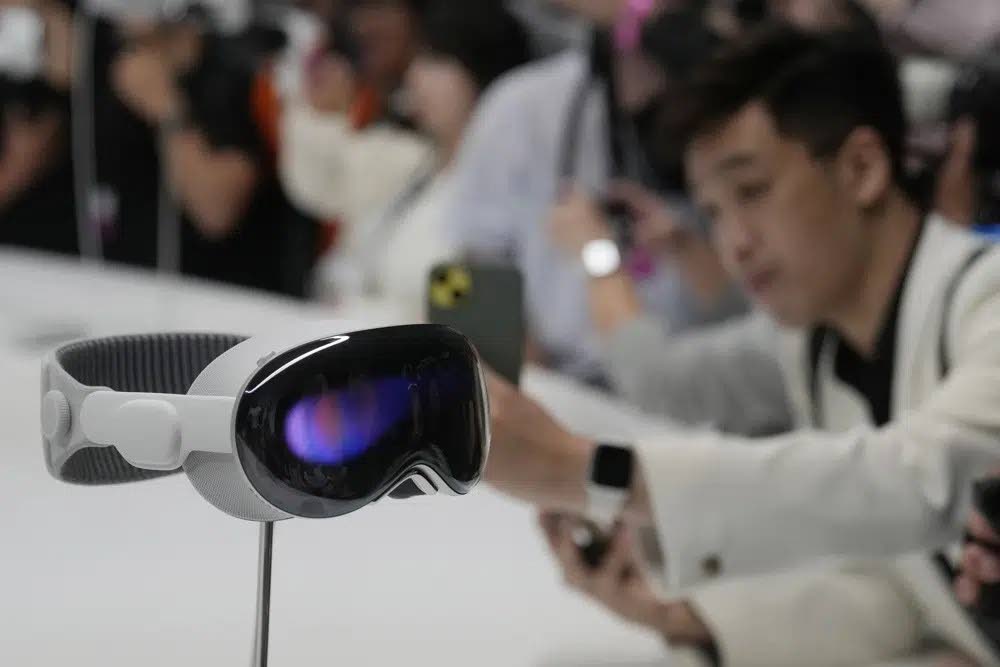Apple's Vision Pro moon shot

Mark Lyndersay
On Wednesday, Apple introduced the Vision Pro, its first product in the VR space. Except Apple doesn't want you to call it that. The company describes the headset as a "spatial computer," and to be fair, the way it seems to work has more in common with augmented reality (AR) than the kind of VR spaces that have traditionally been the sales pitch for this kind of headgear.
Vision Pro is not available for sale. It won't be on the market for at least nine months, so announcing it early gives competitors a chance to respond, but it also gives Apple developers an opportunity to figure out how to bring their apps to the product.
Unlike most headsets, which are usually connected to a computing device, the Vision Pro is a computer, one with dual 4K displays and an array of cameras both outside and inside it.
The computer runs VisionOS, a version of iOS that's optimised for eye tracing input, movement tracking, voice recognition and virtual input.
The internal cameras track where your eyes are looking to give emphasis to objects on the screen, while the external cameras capture a feed of your environment to project on its screens and to track the movement of your hands.
You do not hold physical controllers to use the Vision Pro.
Swipe gestures register as scrolling, touching a thumb and index finger together registers as a click. Where you look becomes the point of focus on the screen.
In Apple's videos, the user experience is a mix of computer windows of varying sizes layered on top of live video of the physical environment.
In a curious touch, the device also sports a screen on its face, which is normally determinedly "blind" on a headset. The screen either shows a swirly, smoky image or a feature called EyeSight projects a rendering of the user's eyes as they would be seen if the face of the headset was actually transparent (it's glass, but opaque).
Why a moon shot? Well, for one thing, the Vision Pro is nose-bleed expensive at US$3,499. Meta's Quest Pro retails for US$999 by comparison (down from an introductory price of $1,499).

There are more expensive VR headsets for specific use cases, but the Quest Pro is the device that most users will compare to Apple's headset.
It's arguable that they aren't being developed to do the same things, despite operating on similar principles. That nine-month lead is probably strategic, giving Apple's developer a community a chance to build software that will really distinguish the Vision Pro in the market.
In other bad news, the device is connected via cable to a rechargeable brick the size of chunky iPhone that runs the headset for just two hours. There is the option of an AC outlet, but who wants to be connected to a wall socket?
One benefit of being on the planet for a while is seeing what happened to the first Macintosh (underpowered, overpriced), the first PowerBook (underpowered, underwhelming), the first iPod (pretended that Macs were the only computers in existence), the first iPhone (no apps aside from Apple's) and the first iPad (What is this for?).
The success of each of these devices is often attributed to their style and elegance, but beyond pretty, technology has to be useful and that's where smart developers have always taken Apple's hardware past the post.
The company introduces the devices with just enough to make them useful, ever since the days of MacWrite and MacDraw, but it's tools like Excel, Photoshop and DaVinci Resolve that have made the difference in the company's fortunes.
So while it's tempting to dismiss the Vision Pro as another Apple pretty face for champagne tastes, it's only version 1.0.
Dubbing the product Pro leaves the window open for standard and "SE" versions that might focus on the features that prove most appealing to end users after early adopters with deep pockets take the Vision Pro for a spin.
It would also be a mistake to underestimate the effort that's been invested into the user interface for the Vision Pro.
Something as simple as unlocking a user's profile on the device is accomplished using Iris detection. The capacity to use gestures, freed from additional hardware to interact with virtual space, gives software developers a new interactive playground to romp in.
It wouldn't be overselling the launch of this new headset to characterise the technical improvements that it's bringing to the table as just the kind of butt-kicking that VR needed after years of trying to sell virtual worlds populated by avatars without legs.
Mark Lyndersay is the editor of technewstt.com. An expanded version of this column can be found there.

Comments
"Apple’s Vision Pro moon shot"